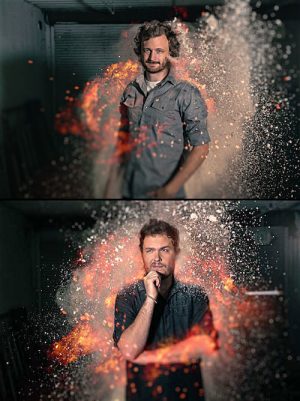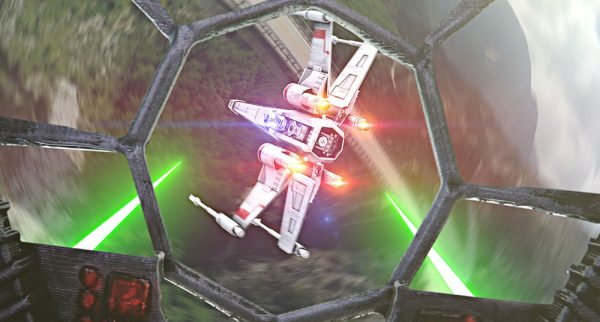 A big production topic of the past few years has been drones, drones and more drones. And when it comes to hyper realistic aerial chases, no one does it better than Corridor Digital. Known for their insane VFX tricks and professional quality fan films on YouTube, creators and filmmakers Niko Pueringer and Sam Gorski will do just about anything to get that perfect shot, even 3D printing and hand painting racing drones to replicate Star Wars ships and racing them in the air above a national forest. It is quite the joyride.
A big production topic of the past few years has been drones, drones and more drones. And when it comes to hyper realistic aerial chases, no one does it better than Corridor Digital. Known for their insane VFX tricks and professional quality fan films on YouTube, creators and filmmakers Niko Pueringer and Sam Gorski will do just about anything to get that perfect shot, even 3D printing and hand painting racing drones to replicate Star Wars ships and racing them in the air above a national forest. It is quite the joyride.
Shot in the style of a classic Star Wars space battle, the YouTube hit “Drone Star Wars” is Corridor Digital’s spin on an aerial battle between the Empire and the Rebels. Gorski and Pueringer’s short film now has more than 1.5 million views, and it’s easy to see why. It’s like slipping on a virtual reality headset and buckling your seatbelt to pilot your own drone.
For “Drone Star Wars,” the Corridor Digital team wanted to give the footage a somewhat unnatural feel, like that of a classic sci fi movie (say, for example, Star Wars!), which meant incorporating vibrant, rich colors that would really pop. Because the footage was shot on a couple of drones, Corridor Digital had to be careful to maintain the realistic look of the chase. This meant that the color grading process was vital, and unlike most typical YouTube videos, Corridor Digital worked with a full set of tools to make the aerial battle stand out. They chose Blackmagic DaVinci Resolve to pull the colors while retaining the quality.
Pueringer explained,
“We really pushed it to be more than just drone footage, and with Resolve, it was easy to adjust the colors to give the film life. It’s an excellent tool for highlighting specific colors and hues and tones. For example, we were able to select all the green leaves and bushes, which looked a bit dusty, and pop them into a deeper blue green. You just don’t get that in that forest environment, so it’s crucial that we’re able to create it in post.”
In fact, Pueringer’s favorite part of post is color grading, and after all of the pains Corridor Digital took to make sure the drone shoot was perfect, it was important that they transform the flat green forest background in post to get the full effect.
“Our color grading really allowed us to achieve that sci fi look we were going for,” says Pueringer. “We also wanted a desert style color with the rocks. We wanted it to feel like we were really on another planet. With Resolve, we were able to isolate the tan tones of the rocks and push them in a stronger direction to become a bit more saturated and create a dual tone color pop for earth. The deep blues and silvery whites of the sky as well as other parts of the scenery were able to retain their color while other parts became a more powerful orange.”
Giving the footage the full treatment in post really took it past typical drone footage. Take one look at the cinematic quality of “Drone Star Wars” and you’ll forget you’re even watching aerial footage shot on remote control drones. It looks like something you’d see on the big screen. But just because it looks like big screen material doesn’t mean it’s seen on the big screen, or any typical screen at all for that matter.
“When shooting a high quality YouTube video like this, it’s important to keep in mind that people will be viewing it on different sized screens, whether that’s a mobile device, tablet, laptop or what have you,” Pueringer says. “Generally, it’s good to sharpen things a bit, particularly with drone footage. We tend to use a different kind of sharpening tool with a bigger radius so it will still look great on a phone screen. With our software, we can hone in on elements based on where we think people will be watching.”
The talented Corridor Digital team couldn’t be more clued in to what their audience is watching and what they want to see more of, and “Drone Star Wars” is no exception. They consistently churn out short films on YouTube that are not only top notch quality, but wildly engaging, which means the demand for new material is pretty high. Pueringer goes on to state that the fact their software is able to run on the GPU makes it able to speed through their workload, as does its design layout for mask tracking, node usage, and color blending.
He continues, “We also do a lot of work with LUTs (Look Up Tables), so to be able to easily and quickly create a really complicated node structure then pop it out to a LUT, disable nodes and still have same color fidelity is pretty amazing. It’s great for us to revisit old color grades, which we do often, and see how footage looks with old color grades applied.”
At the end of the day (or the shoot), Pueringer is just happy to sit down and get to grading, which still amazes him as to what he and his partner are able to accomplish with today’s technology:
“This was impossible years ago, and I get excited by the potential of my footage every time I sit down to grade.”
Behind The Scenes of “Drone Star Wars”
Shooting a top notch YouTube video requires a little extra TLC in post, but even the most ordinary footage can transform into the extraordinary with perseverance and the right tools. (Well, that and a couple of awesome hand painted Star Wars drones.)
Check out Corridor Digital’s website to see how all the action pans out with this and other films!


